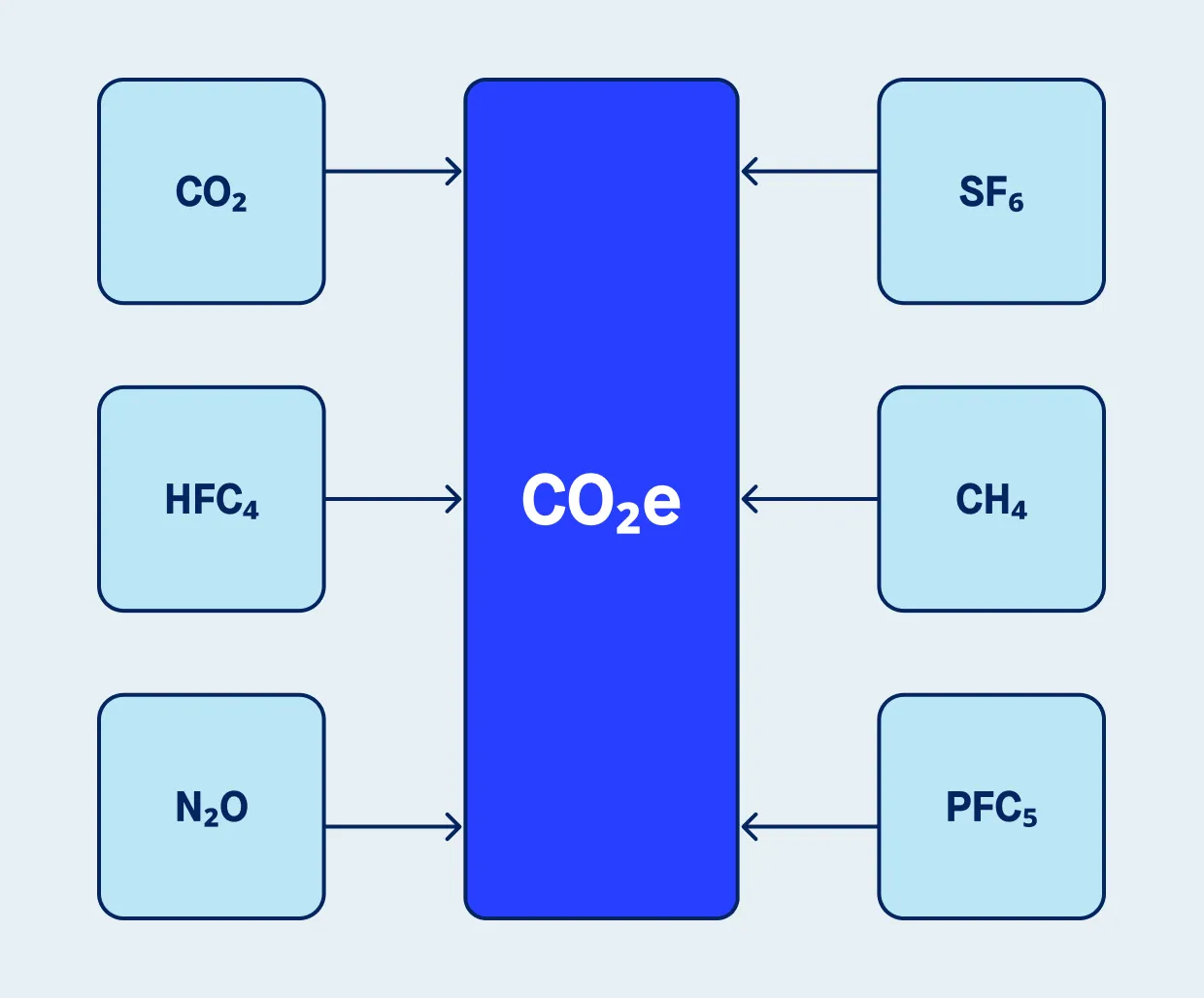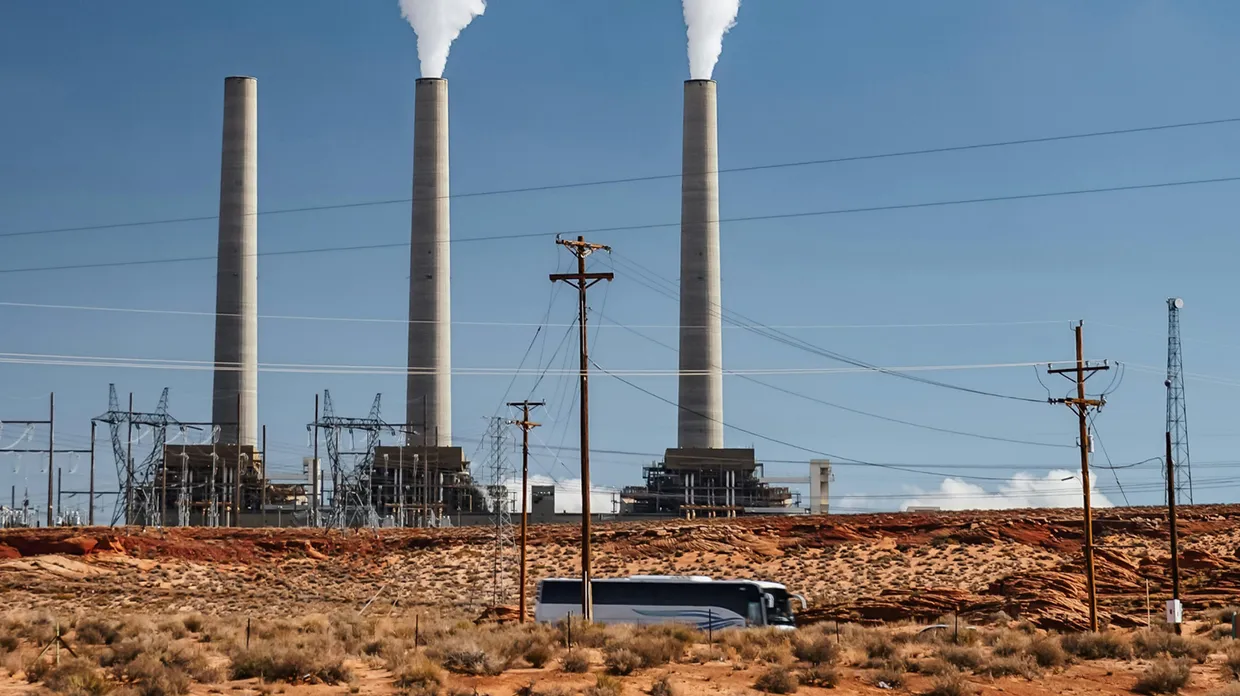What are greenhouse gas emissions?
Greenhouse gases are a group of gases that trap heat in the earth’s atmosphere, keeping the planet warm enough to sustain life. This natural process, called the greenhouse effect, becomes harmful when human activities release excessive amounts of these gases, increasing greenhouse gas concentrations and leading to global warming.
When people talk about greenhouse gas emissions, they refer to all gases released from fossil fuel combustion, industrial processes, agriculture, and other human or natural sources that contribute to warming.
The main greenhouse gases include:
- Carbon dioxide (CO₂), released from burning fossil fuels such as coal, oil, and natural gas, and from land use change such as deforestation.
- Methane (CH₄), emitted from natural gas extraction, livestock, landfills, and agricultural soils.
- Nitrous oxide (N₂O), produced by fertilized soils, industrial activities, and certain manufacturing processes.
- Hydrofluorocarbons (HFC₄), synthetic gases used in refrigeration and air conditioning.
- Perfluorocarbons (PFC₅), emitted during aluminum production and semiconductor manufacturing.
- Sulfur hexafluoride (SF₆), used as an insulating gas in electrical equipment and among the most powerful greenhouse gases.
Each of these gases has a different capacity to trap heat and remains in the atmosphere for different lengths of time. To compare their overall warming impact, emissions are expressed as CO₂e (carbon dioxide equivalent) – a standard metric that converts each gas’s effect into the amount of CO₂ that would cause the same level of warming. This allows organizations and policymakers to measure total greenhouse gas emissions consistently and accurately.

How do GHG emissions differ from carbon emissions?
The terms carbon emissions and greenhouse gas emissions are often used interchangeably, but they are not identical. Carbon emissions refer specifically to carbon dioxide emissions, which are the largest contributor to global greenhouse gas emissions from human activity.
Carbon dioxide comes mainly from fossil fuels burned for electricity use, heating, and transportation. It is the largest contributor to total greenhouse gas emissions worldwide, responsible for roughly three-quarters of the global rise in earth’s temperature, according to the Intergovernmental Panel on Climate Change.
Other greenhouse gases such as methane, nitrous oxide, and fluorinated gases make up smaller portions of total emissions, but many of these gases are far more effective at trapping heat than carbon dioxide.
While carbon emissions are a part of the picture, greenhouse gas emissions represent the full range of gases that contribute to global warming.
What is the GHG Protocol?
The Greenhouse Gas Protocol, or GHG Protocol, is the most widely used international standard for measuring and reporting greenhouse gas emissions. It was developed by the World Resources Institute and the World Business Council for Sustainable Development, supported by findings from the Intergovernmental Panel on Climate Change and its Working Group I, whose Sixth Assessment Report was published by Cambridge University Press.
The GHG Protocol divides greenhouse gas emissions into three categories, known as scopes:
- Scope 1 covers direct greenhouse gas emissions from sources owned or controlled by a company, such as emissions from company vehicles or onsite fossil fuel combustion.
- Scope 2 covers indirect emissions from purchased electricity, heating, or cooling that the company consumes but does not produce.
- Scope 3 includes all other indirect emissions throughout the value chain, from suppliers and transportation to product use and disposal.
Together, these scopes cover total greenhouse gas emissions for an organization. Many companies find that Scope 3 makes up the majority of their impact because it includes the supply chain and other economic sectors outside their direct control.
The GHG Protocol provides a common language for organizations and countries to measure, manage, and report emissions consistently. It underpins most carbon accounting systems, climate disclosures, and the Paris Agreement.
For businesses, greenhouse gas emissions are central to managing a carbon footprint. A company’s carbon footprint represents the sum of all direct and indirect emissions generated through economic activity, from energy use and manufacturing processes to logistics and product life cycles.
By calculating total emissions, organizations can identify areas with higher emissions, set reduction targets, and track progress toward a low carbon economy.
Greenhouse gas accounting step by step
- Measuring the baseline: Companies begin by quantifying direct emissions and indirect emissions using the GHG Protocol.
- Identifying hotspots: Data on industrial emissions, electricity use, and the transportation sector help locate the largest contributors to global emissions.
- Setting reduction strategies: Insights into carbon intensity and energy use guide efforts to reduce greenhouse gases, including switching to renewable energy or using carbon sinks such as forests.
- Reporting and compliance: Reliable gas emissions data build transparency, helping businesses meet both voluntary and regulatory climate goals.
Managing greenhouse gas emissions is not just about compliance. It enables organizations to improve efficiency, reduce costs, and demonstrate progress toward sustainable business practices.
Common sources of greenhouse gas emissions
Human emissions of greenhouse gases come from nearly every economic sector. The largest sources of global emissions include:
- Energy and electricity production: The burning of fossil fuels such as coal and natural gas remains the largest contributor to global greenhouse gas emissions.
- Transportation sector: Cars, trucks, ships, and aircraft generate carbon dioxide emissions through fossil fuel combustion.
- Industry: Manufacturing processes and the construction industry release industrial emissions including nitrous oxide and fluorinated gases.
- Agriculture: Methane emissions from livestock and nitrous oxide from agricultural soils contribute significantly to total greenhouse gas emissions.
- Land use change: Forest fires, deforestation, and land clearing release carbon dioxide and reduce carbon sinks that absorb CO₂.
- Buildings: Energy consumption for heating, cooling, and lighting increases electricity use and related indirect emissions.
Each world region has its own emissions profile based on energy mix, land use, and economic activity.
Common challenges in GHG emissions accounting
Accurately measuring greenhouse gas emissions remains one of the biggest challenges in carbon accounting. For global companies with complex supply chains, ensuring accuracy and completeness is not simple.
Data availability and quality
Many businesses still rely on rough estimates or incomplete data, particularly for Scope 3 emissions. Without real data, it is difficult to calculate total emissions or assess carbon intensity across operations.
Complex value chains
Global greenhouse gas emissions are distributed across thousands of suppliers and facilities. Gathering consistent information requires collaboration and shared standards.
Evolving methodologies
The science of greenhouse gas accounting continues to develop as researchers learn more about industrial processes and the effects of different gases. Keeping up with updated methods and regional regulations requires time and expertise.
Double counting
If data boundaries are unclear, companies risk counting the same emissions twice. Using the GHG Protocol helps prevent duplication.
Verification and assurance
As reporting standards strengthen, organizations must ensure their data is traceable and auditable. Assurance processes validate accuracy and build stakeholder confidence.
The global context of GHG emissions
The impact of greenhouse gas emissions worldwide extends far beyond any single company or country. Increasing greenhouse gas concentrations drive global temperatures higher, raising sea levels and disrupting weather patterns.
The Intergovernmental Panel on Climate Change confirms that human activity is the largest contributor to observed warming since the industrial era. Fossil fuels burned for energy use and industrial processes remain the primary source of total greenhouse gas emissions.
As emissions rise, land areas experience extreme heat, drought, and more intense storms. Reducing global greenhouse gas emissions is critical to limit warming to 1.5°C under the Paris Agreement. Achieving this target requires every economic sector to reduce emissions, shift to renewable energy, and strengthen natural carbon sinks.
Reducing greenhouse gas emissions
Reducing greenhouse gases requires coordinated action across industries and governments. Key approaches include:
- Replacing fossil fuels with renewable energy such as solar, wind, and geothermal power.
- Improving energy efficiency in industry, buildings, and transportation.
- Investing in carbon capture technologies to store industrial emissions.
- Promoting sustainable agriculture to reduce methane and nitrous oxide.
- Protecting and expanding forests to enhance natural carbon sinks.
For businesses, accurate measurement is the foundation of action. Using carbon accounting platforms aligned with the GHG Protocol helps quantify direct emissions, indirect emissions, and total greenhouse gas emissions. With this data, organizations can design reduction strategies that are credible and measurable.
Why carbon accounting matters for your business
Understanding and accounting for greenhouse gases isn’t just about sustainability, it’s about strategy. Carbon accounting helps you identify inefficiencies, cut costs, and reduce risk while building trust with investors, customers, and regulators.
Starting now puts you ahead of upcoming disclosure requirements and gives you the data foundation to make smarter decisions. By tracking your emissions today, you can turn climate responsibility into business opportunity and long-term growth.





